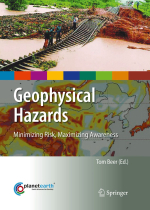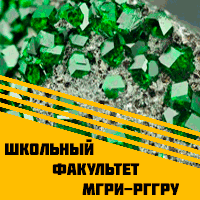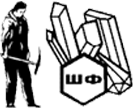Добрый день, Коллеги. Важное сообщение, просьба принять участие. Музей Ферсмана ищет помощь для реставрационных работ в помещении. Подробности по ссылке
Geophysical hazards. Minimizimg risk, maximizing awareness / Геофизические опасности. Минимизация риска, повышение осведомленности
The International Year of Planet Earth (IYPE) was established as a means of raising worldwide public and political awareness of the vast, though frequently under-used, potential the Earth Sciences possess for improving the quality of life of the peoples of the world and safeguarding Earth’s rich and diverse environments.
The International Year project was jointly initiated in 2000 by the International Union of Geological Sciences (IUGS) and the Earth Science Division of the United Nations Educational, Scientific and Cultural Organisation (UNESCO). IUGS, which is a Non-Governmental Organisation, and UNESCO, an Inter-Governmental Organisation, already shared a long record of productive cooperation in the natural sciences and their application to societal problems, including the International Geoscience Programme (IGCP) now in its fourth decade.
With its main goals of raising public awareness of, and enhancing research in the Earth sciences on a global scale in both the developed and less-developed countries of the world, two operational programmes were demanded. In 2002 and 2003, the Series Editors together with Dr. Ted Nield and Dr. Henk Schalke (all four being core members of the Management Team at that time) drew up outlines of a Science and an Outreach Programme. In 2005, following the UN proclamation of 2008 as the United Nations International Year of Planet Earth, the “Year” grew into a triennium (2007–2009).
The Outreach Programme, targeting all levels of human society from decisionmakers to the general public, achieved considerable success in the hands of member states representing over 80% of the global population. The Science Programme concentrated on bringing together like-minded scientists from around the world to advance collaborative science in a number of areas of global concern. A strong emphasis on enhancing the role of the Earth sciences in building a healthier, safer and wealthier society was adopted – as declared in the Year’s logo strap-line “Earth Sciences for Society”.
The organisational approach adopted by the Science Programme involved recognition of ten global themes that embrace a broad range of problems of widespread national and international concern, as follows. <...>
Part I The IYPE Hazards Theme: Minimising Risk, Maximising Awareness
The Hazards Theme of the International Year of Planet Earth
Tom Beer
Social Science Perspectives on Hazards and Vulnerability Science
Susan L. Cutter
Focusing on the Environment and Human Security Nexus
Juan Carlos Villagran de Leon and Janos J. Bogardi
Communicating Geological Hazards: Educating, Training and Assisting Geoscientists in Communication Skills
David Liverman
Part II The Response of the International Scientific Community
Introduction of a New International Research Program:
Integrated Research on Disaster Risk - The Challenge of Natural and Human-Induced Environmental Hazards
Gordon A. McBean
Building a University Network for Disaster Risk Reduction in sub-Saharan Africa
Genene Mulugeta
Co-operation Plan on Hazards & Disasters Risk Reduction in Asia and the Pacific
Harsh Gupta
Part III Geophysical Risk and Sustainability: Climate and Climate Change
Closing the Gap Between Science and Practice to Reduce Human Losses in Hydro-Meteorological Disasters
Kuniyoshi Takeuchi
The Role of Geosciences in the Mitigation of Natural Disasters: Five Case Studies
S.A.G. Leroy, S. Warny, H. Lahijani, E.L. Piovano, D. Fanetti, and A.R. Berger
Part IV Geophysical Risk and Sustainability: Theory and Practice ..
Seismic Hazard in India - Practical Aspects and Initiatives During IYPE R.K. Chadha
Computational Geodynamics as a Component of Comprehensive Seismic Hazards Analysis
Alik Ismail-Zadeh
Hazards in the Coastal Zones Related to Groundwater-Seawater Interaction Processes
Y. A. Kontar, Yu.R. Ozorovich, and A.T. Salokhiddinnov
Part V GeoHazards and Risks - Observation and Assessment
Mega Tsunami of the World Oceans: Chevron Dune Formation, Micro-Ejecta, and Rapid Climate Change as the Evidence of Recent Oceanic Bolide Impacts
Viacheslav Gusiakov, Dallas H. Abbott, Edward A. Bryant, W. Bruce Masse, and Dee Breger
Understanding Slow Deformation Before Dynamic Failure
G. Ventura, S. Vinciguerra, S. Moretti, P.H. Meredith, M.J. Heap,P.
Baud, S.A. Shapiro, C. Dinske, and J. Kummerow
Landslides in Mountain Regions: Hazards, Resources and Information
Raisa Gracheva and Alexandra Golyeva




